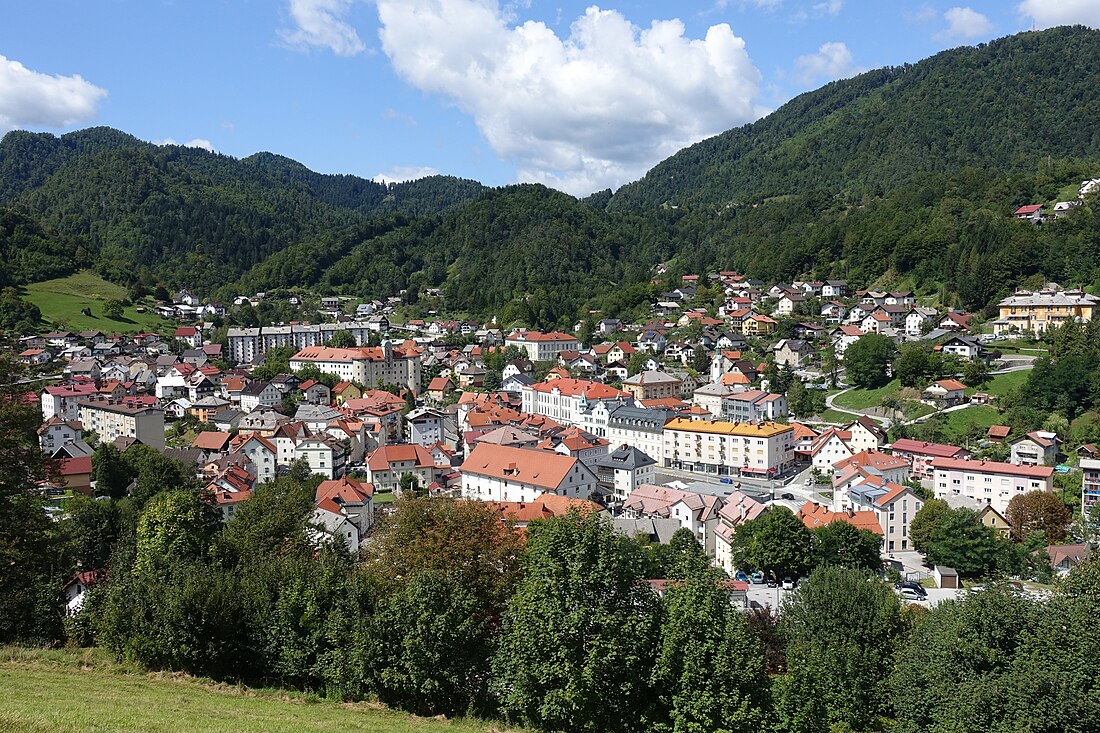Top Qs
Timeline
Chat
Perspective
Idrija
Town in Inner Carniola, Slovenia From Wikipedia, the free encyclopedia
Remove ads
Idrija (pronounced [ˈìːdɾija] ⓘ, in older sources Zgornja Idrija;[2] German: (Ober)idria,[2][3] Italian: Idria) is a town in western Slovenia. It is the seat of the Municipality of Idrija. It is notable for its mercury mine with stores and infrastructure, as well as miners' living quarters, and a miners' theatre. Together with the Spanish mine at Almadén, it has been a UNESCO World Heritage Site since 2012.[4] In 2011, Idrija was given the Alpine Town of the Year award.[5][6]
Remove ads
Geography

The town of Idrija lies in the Idrija Basin, surrounded by the Idrija Hills, in the traditional region of Inner Carniola[7] and in the Gorizia Statistical Region. Today, its inhabitants mostly consider it part of the Slovene Littoral.[8] It is traversed by the Idrijca River, which is joined there by Nikova Creek. It includes the neighborhoods of Brusovše, Cegovnica, Prenjuta, and Žabja Vas close to the town center, as well as the more outlying hamlets of Češnjice, Ljubevč, Marof, Mokraška Vas, Podroteja, Staje, and Zahoda. The Marof hydroelectric plant is located on the Idrijca River on the northern outskirts of Idrija, between Marof and Mokraška Vas. Springs in the area include Podroteja Spring[9] and Wild Lake on the Idrijca River south of the town.
Remove ads
History
Summarize
Perspective
Mercury was discovered in Idrija (known as Idria under Austrian rule) in the late 15th century (various sources cite 1490,[10][11][12] 1492,[13][14] and 1497[10][12]). To support the mining activities, Gewerkenegg Castle was constructed between 1522 and 1533 by the mine owners.[15] Mining operations were taken over by the government in 1580.[16] The mineral idrialite, discovered here in 1832, is named after the town.[17]
Idrija mercury mine
In the Middle Ages, Idrija was managed by the Patriarchate of Aquileia and the Counts of Gorizia as part of the Governorate of Tolmin, which became independent in the 15th century. After 1500, Idrija was occupied for one year by the Republic of Venice (in 1508), but it was otherwise governed by the House of Habsburg. In March 1511, it was affected by the forceful 1511 Idrija earthquake.[18] For long time Idrija was a cornerstone of the global supply of mercury.[19] As such, Idrija supplied mercury needed in the silver mines of the Spanish Empire when the mercury mines of Almadén and Huancavelica faltered in their deliveries.[19] In the 18th century, Idrija gained the rights of a market town. From 1783 until the 1910s, it was part of the Inner Carniola Kreis. In 1920, it came under Italy with the Treaty of Rapallo.[20][21] In September 1943, it became part of the Nazi Germany and was then heavily rocketed by the SAAF in 1945.[22] After the war, it formed part of the Socialist Republic of Slovenia within Yugoslavia and became a town in independent Slovenia in June 1991.
Legend
According to legend, a bucket maker working in a local spring spotted a small amount of liquid mercury in 1490.[23] Idrija is one of the few places in the world where mercury occurs in both its native state and as cinnabar (mercury sulfide) ore. The subterranean shaft mine entrance known as Anthony's Shaft (Antonijev rov) is used today for tours of the upper levels, complete with life-sized depictions of workers over the ages. The lower levels, which extend to almost 400 meters below the surface and are no longer being actively mined, are currently being cleaned up.
Remove ads
Church
The parish church in the town is dedicated to Saint Joseph the Worker and belongs to the Diocese of Koper. There are three other churches in Idrija, dedicated to the Holy Trinity, Saint Anthony of Padua, and Our Lady of Sorrows.[24]
Notable people
Summarize
Perspective
Notable people who were born or lived in Idrija include:
- Aleš Bebler (1907–1981), Slovene Communist leader, resistance fighter, and diplomat
- Jožef Blasnik (1800–1872), printer, publisher
- Stanko Bloudek (1890–1959), designer
- Borut Božič (born 1980), professional road cyclist
- Aleš Čar (born 1971), writer
- Karel Dežman (1821–1889), Carniolan politician and scholar
- Damir Feigel (1879–1959), writer, journalist, cultural worker, satirist, humorist, father of Slovenian science fiction, national awakener and anti-fascism fighter
- Heinrich Freyer (1802–1866), Slovenian botanist, cartographer, pharmacist and natural scientist
- Ludvik Grilc (1851–1910), painter/portrait painter
- Belsazar Hacquet (1739/40–1815), French natural scientist
- Vladimír Karfík (1901–1996), Czechoslovak architect
- Eva Lucija Cecilija Viktorija Emilija Kraus, (1785–1845), Baroness of Wolsberg, lover of French Emperor Napoleon
- Marko V. Lipold (1816–1883), Miner, geologist and lawyer, known as the father of Slovenian geology
- Jožef Mrak (1709–1786), one of the most notable Slovenian polytechnicians
- Pier Paolo Pasolini (1922–1975), Italian film director and poet
- Vasja Pirc (1907–1980), chess grandmaster
- Nikolaj Pirnat (1903–1948), sculptor, painter, illustrator and author
- Zorko Prelovec (1887–1939), musician, composer, choir composition author
- Luka Rupnik (born 1993), Slovenian basketball player
- Marko Ivan Rupnik (born 1954), artist, philosopher and theologian
- Giovanni Antonio Scopoli (1723–1788), Italian natural scientist
- Jan Tratnik (born 1990), professional road cyclist
- Anton Aloys Wolf (1782–1859), Roman Catholic bishop, philanthropist, patron of literature
Remove ads
See also
- The ghost town of New Idria, California, a site of mercury mining during the 19th-century California Gold Rush, was named after Idrija.
References
External links
Wikiwand - on
Seamless Wikipedia browsing. On steroids.
Remove ads











